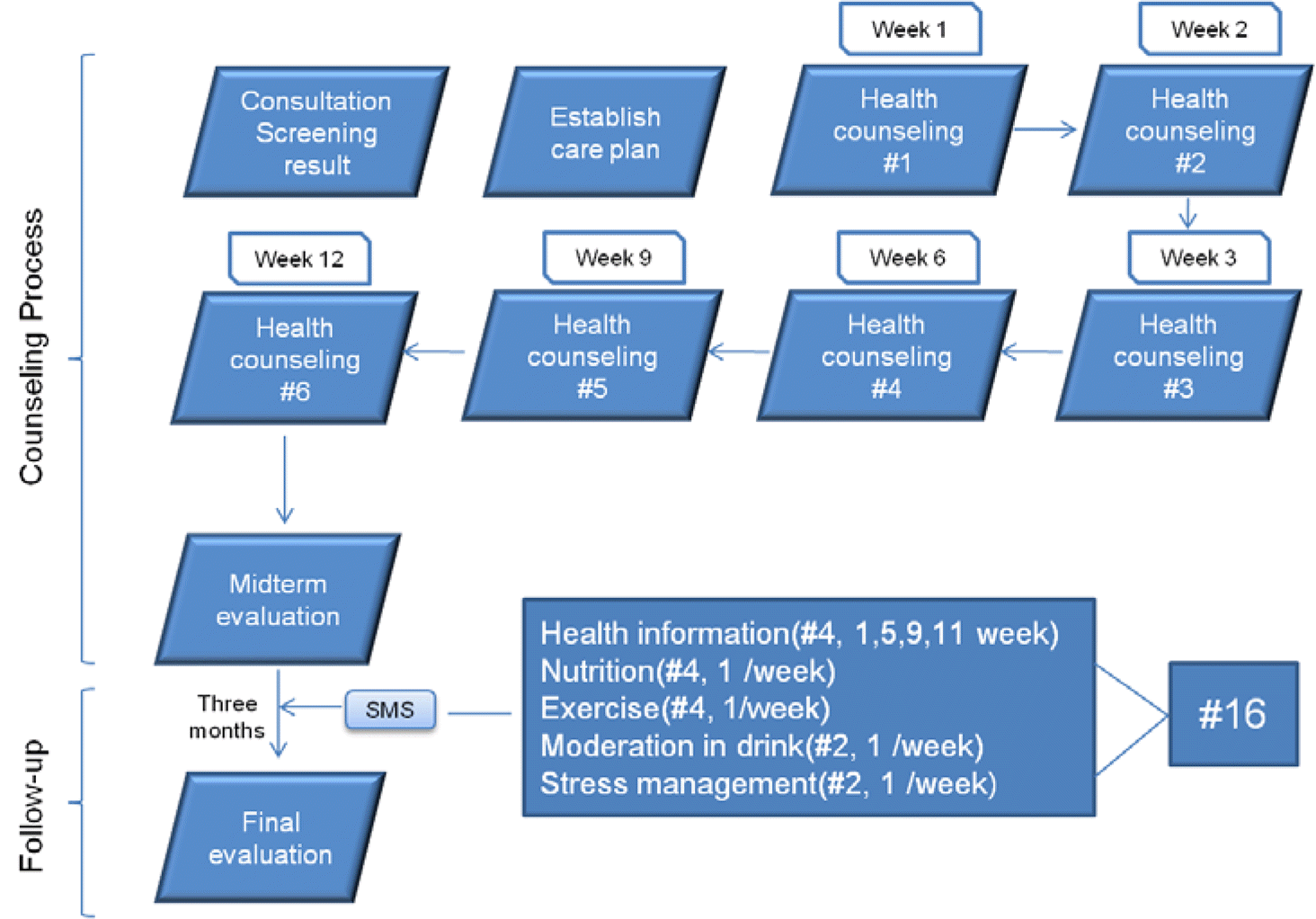Abstract
Purpose
The aim of the study was to identify the effects of education from using cellular phones and a short messaging service.
Methods
Collected data included baseline demographics, blood pressure, abdominal circumference, total cholesterol, body mass index and health behavior index (Dietary Practice Guidelines Score, Physical Activity, Drinking frequency, Stress score, Subjective health status, and Action change stage score). Data were collected at public health centers in Chungcheongnam-do from January to December, 2011. Data obtained from Individual health counseling Programs in Chungcheongnam-do. Analysis was divided into health risk group and Disease management group, using a paired t test.
Results
Following the education of using short messaging service of cellular phones Health risk group was a reduction in the systolic blood pressure, diastolic blood pressure, waist circumference. Disease management group was a reduction in the systolic blood pressure and body mass index. In both groups, there were improvement in the Health behavior index; dietary practice guidelines score, physical activity, stress score, subjective health status and action change stage scores.
Go to : 
REFERENCES
Beverly B. G.., Timothy M.., Michael H.., Madsen L.., Madlen C.., Diana B.2002. Effectiveness of telephone support in Increasing physical activity levels in primary care patient. American Journal of Preventive Medicine. 22(3):177–183.
Chang S. O.., Kim E. J.., Kil S. Y.., Seomun G. A.., Lee S. J.2005. Influential variables on intention and action to quit smoking between adolescent smokers and adult smokersbased on the transtheoretical model. Journal of the Korean Academy of Nursing. 35:1410–1419.

Bramley D.., Riddell T.., Whittaker R.., Corbett T.., Lin R. B.., Wills M., et al. 2005. Smoking cessation using mobile phone text messaging is as effective in Maori as non-Maori. The New Zealand Medical Journal. 118(1216):1–10.
Faul F.., Erdfelder E.., Lang A. G.., Buchner A.2009. Statistical power analyses using G∗ Power 3.1: Tests for correlation and regression analyses. Behavior Research Methods. 41(4):1149–1160.
Ferrini R. L.., Edelstein S.., Barrett-Connor E.1994. The association between health beliefs and health behavior change in older adults. Preventive Medicine. 23(1):1–5.

Haapala I.., Barengo N. C.., Biggs S.., Surakka L.., Manninen P.2009. Weight loss by mobile phone: A 1-year effectiveness study. Public Health Nutrition. 12(12):2382–2391.

Hurling R.., Catt M.., DeBoni M.., Fairley W.., Hurst T.., Murray P., et al. 2007. Using Internet and mobile phone technology to deliver an automated physical activity program: Randomized controlled trial. Journal of Medicine Internet Research. 9(2):1–13.

Joo N. S.., Kim B. T.2007. Mobile phone short message service messaging for behaviour modification in a community-based weight control programme in Korea. Journal of Tele-medicine and Telecare. 13:416–420.

Kim H.., Lee S. G.2012. Effects of an individual health counseling program for community. Korean Journal of Health Education Promotion. 29(2):13–21.
Kim H. S.2003. Fasting blood sugar and adherence to diabetes control recommendation: Impact of education using short messaging service of cellular phone. The Korean Journal of Fundamentals of Nursing. 5(2):13–19.
Kim H. S.., Park H. J.2006. Effects of a nurse short-message service via cellular phones for people with diabetes. The Korean Journal of Fundamentals of Nursing. 13(2):235–241.
Kuntsche E.., Robert B.2009. Short message service technology in alcohol research. Alcohol & Alcoholism. 44(4):423–428.
Lee Y. R.., Kim M. J.2009. A transition of health habits and self-rated health status of women aged in early adulthood. Journal of Korean Academy of Public Health Nursing. 23(2):199–206.
Marquez C. E.., Figuera W. M.., Guillen V.., Figueras M.., Balana M.., Maval J.2004. Effectiveness of an intervention to provide information to patients with hypertension as short text messages of reminders sent to their mobile phone. Atencion Primaria. 34(8):399–405.
Meloche J.2003. Cooking with class: Participation soars with hands-on learning and take-aways. Journal of Nutrition Education Behavior. 35(2):107.

Ministry of Health and Welfare. 2005. Handbook of health promotion. Seoul, Korea: Author.
Ministry of Health and Welfare. 2009. Handbook of health promotion. Seoul, Korea: Author.
Ministry of Health and Welfare. 2011. Guideline of health promotion for community. Seoul, Korea: Author.
Nam J. G.2000. Health educations strategy for local health department. Journal of Korean Society for Health Education and Promotion. 17(1):171–184.
Park S. Y.., Yang Y. J.., Kim Y. R.2011. Effects of nutrition education using a ubiquitous healthcare(u-health) service on metabolic syndrome in male workers. The Korean Journal Nutrition. 44(3):231–242.
Oh H. S.., Jang M.., Hwang M. O.., Cho S. W.., Paek Y. M.., Choi T. I., et al. 2009. Effect of 1 year E-mail nutrition education after face to face encounter at worksite: Changes in cardiovascular risk factors. The Korean Journal Nutrition. 42(6):559–566.
Yang J. G.2009. Effects of nutrition education program for elderly with hypertension at the public health center: Focused on individual energy intake. Unpublished master thesis, Jeonbuk university, Jeonju.
Yoon K. H.., Kim H. S.2008. A short message service by cellular phone in type2. Diabetes Research and Clinical Practice. 79:256–261.
Go to : 
Table 1.
Sociodemographic Characteristics of Participants
Table 2.
Effect of Health One-stop Service Program on Health Behavior Variables
Table 3.
Effect of Health One-stop Service on Health Measurement Variables




 PDF
PDF ePub
ePub Citation
Citation Print
Print



 XML Download
XML Download